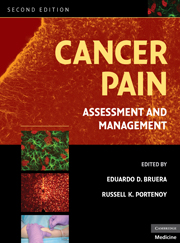Book contents
- Frontmatter
- Contents
- Contributors
- Preface
- SECTION I MECHANISMS AND EPIDEMIOLOGY
- SECTION II EPIDEMIOLOGY AND SYNDROMES
- 3 Cancer pain epidemiology
- 4 Cancer pain syndromes
- SECTION III ASSESSMENT
- SECTION IV PHARMACOLOGICAL TREATMENT
- SECTION V OTHER INTERVENTIONAL STRATEGIES
- SECTION VI REHABILITATION AND PSYCHOLOGICAL INTERVENTIONS
- SECTION VII THE ROLE OF ANTINEOPLASTIC THERAPIES IN PAIN CONTROL
- SECTION VIII PAIN IN SPECIAL POPULATIONS
- SECTION IX DIFFICULT PAIN PROBLEMS
- SECTION X SYSTEMS OF CARE
- Index
- Plate section
- References
4 - Cancer pain syndromes
from SECTION II - EPIDEMIOLOGY AND SYNDROMES
Published online by Cambridge University Press: 06 July 2010
- Frontmatter
- Contents
- Contributors
- Preface
- SECTION I MECHANISMS AND EPIDEMIOLOGY
- SECTION II EPIDEMIOLOGY AND SYNDROMES
- 3 Cancer pain epidemiology
- 4 Cancer pain syndromes
- SECTION III ASSESSMENT
- SECTION IV PHARMACOLOGICAL TREATMENT
- SECTION V OTHER INTERVENTIONAL STRATEGIES
- SECTION VI REHABILITATION AND PSYCHOLOGICAL INTERVENTIONS
- SECTION VII THE ROLE OF ANTINEOPLASTIC THERAPIES IN PAIN CONTROL
- SECTION VIII PAIN IN SPECIAL POPULATIONS
- SECTION IX DIFFICULT PAIN PROBLEMS
- SECTION X SYSTEMS OF CARE
- Index
- Plate section
- References
Summary
Introduction
The reported prevalence of cancer pain varies across studies and is highly influenced by the population evaluated, stage of disease, and treatment setting. The overall prevalence is between 33% and 50% and is considerably higher – above 70%–among those with advanced disease.
Chronic pain adversely affects all domains of quality of life, including physical functioning and well-being, mood and coping, and social interactions. Pain may be a focus on problematic communication with health professionals or contribute to distress through its association with disease progression or recurrence. Although not an independent predictor of poor prognosis, uncontrolled pain has been linked to suicidal ideation.
Although pain is widely regarded to be a significant problem in oncology, management continues to be compromised by under-recognition and undertreatment. Good pain control may reduce hospitalizations, physician and emergency room visits, and overall health care costs, and should be considered a best practice in cancer care. Effective control of pain and other symptoms is the foundation for the array of psychological and spiritual processes that together assist the patient in coping with the rigors of the disease and its treatment. The latter processes, in turn, may contribute to symptom relief, an observation underscored by the diversity of effective nonpharmacological approaches to pain treatment.
Pain assessment and classification
Given the high prevalence of cancer pain and its potential for profound adverse consequences, all patients with active disease should be routinely screened for pain.
- Type
- Chapter
- Information
- Cancer PainAssessment and Management, pp. 53 - 86Publisher: Cambridge University PressPrint publication year: 2009
References
- 3
- Cited by



